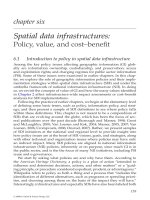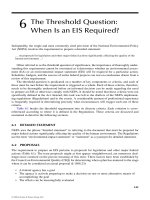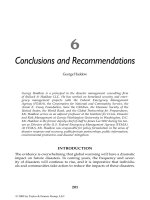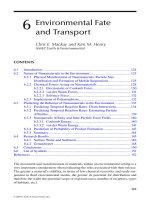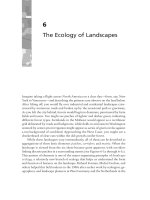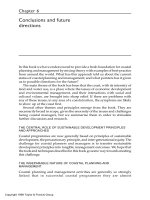Digital Terrain Modeling: Principles and Methodology - Chapter 6 pdf
Bạn đang xem bản rút gọn của tài liệu. Xem và tải ngay bản đầy đủ của tài liệu tại đây (791 KB, 18 trang )
DITM: “tf1732_c006” — 2004/10/20 — 15:44 — page 115 — #1
CHAPTER 6
Interpolation Techniques for
Terrain Surface Modeling
6.1 INTERPOLATION TECHNIQUES: AN OVERVIEW
Interpolation is an approximation problem in mathematics and an estimation problem
in statistics. Interpolation in digital terrain modeling is used to determine the height
value of a point by using the known heights of neighboring points. There are two
implicit assumptions behind interpolation techniques: (a) the terrain surface is con-
tinuous and smooth and (b) there is a high correlation between the neighboring data
points. Interpolation is one of the core techniques in digital terrain modeling because
it is involved in the various stages of the modeling process such as quality control,
surface reconstruction, accuracy assessment, terrain analysis, and applications.
Interpolation techniques can be classified according to different criteria and
they can be used for different purposes. Table 6.1 attempts to provide a simple
classification.
By the size of the area for interpolation, two approaches are identified
(Petrie 1990a), that is, area based and point based. In the area-based approach the
surface is constructed by using all the reference (known) points within this area
and the height of any point within this area can be determined by using this con-
structed surface. Area-based interpolation could be either global or local. Global
interpolation involves the construction of a single complex 3-D surface from the
complete data set of measured points, from which the height values of all other
points can be obtained. This is an extreme approach. The usefulness of this type of
technique depends on the complexity of the terrain surface and the actual size of
the area. A more adaptive solution is to divide a large area into a series of patches
of identical shape and size. This is called local or patchwise interpolation. A sur-
face is constructed for each patch by using all the reference points and heights of
all points (to be interpolated) within this patch are obtained from this patch surface.
The size of the patch is determined by the complexity of the area and there could be
115
© 2005 by CRC Press
DITM: “tf1732_c006” — 2004/10/20 — 15:44 — page 116 — #2
116 DIGITAL TERRAIN MODELING: PRINCIPLES AND METHODOLOGY
Table 6.1 A Classification of Interpolation Techniques
Criteria Interpolation Techniques
Size of area for interpolation Point based, area based
(patchwise or global)
Exactness of the surface Exact fitting, best fitting
Smoothness of the surface Linear, nonlinear
Continuity of the surface Step, continuous
Preciseness of the function Precise, approximate
Certainty of the problem Functional, stochastic
Domain of interest Spatial, spectral (i.e., frequency)
Complexity of the phenomenon Analytical, numerical iteration
a certain degree of overlap between neighboring patches to ensure smooth connec-
tion between patches. At the other extreme, a surface could be constructed for the
interpolation of each point, leading to pointwise interpolation. This requires heavy
computation.
In the construction of a surface for interpolation, (whether global, patchwise, or
pointwise), the surface may or may not pass through all the reference points. If it
does pass through all the points, it is an exact reconstruction and is called exact
fitting. However, the surface may not pass through all the reference points, due to
errors in the reference points. In this case, there might be a deviation from each of
these reference points. If such deviations are limited to a minimum, then the surface
is a best fit. This type of interpolation is called best fitting.
A surface could be in the form of steps, as shown in Figure 4.2. This is a discon-
tinuous surface. In many applications, continuity is a requirement, at least visually,
thus a continuous surface can be constructed. The continuous surface may or may not
be smooth. For example, as discussed in Chapter 4, a surface comprising a set of con-
tiguous linear facets is not continuous in the first derivative and thus is not smooth.
Both triangular facets and bilinear surfaces are linear surfaces. Usually, a smooth
surface is constructed by using some kind of higher-order polynomials.
It is also possible to use an approximate function for interpolation if the original
function is too complex or the approximate function is good enough but much
simpler. For example, when x is a very small angle, the value of sin(x) can be
nicely approximated by x itself. In other words, y = x is a very good approximation
of the function y = sin(x) under this condition. In fact, it is also possible (but not
in terrain modeling) that the nature of a phenomenon is too complex and one is not
able to establish an analytical function for the problem, so numerical approximation
by iteration is used.
A problem could be deterministic or probabilistic. For the former, a deterministic
function can be used and for the latter a stochastic model must be used. Sometimes
the small variations on the terrain are so complex that the variation is then treated as
a stochastic process.
Interpolation can take place in either the space or the spectral domain. Most
interpolation techniques for terrain modeling are for spatial interpolation. However,
it is also possible to transform the data into a frequency domain and perform
interpolation there.
© 2005 by CRC Press
DITM: “tf1732_c006” — 2004/10/20 — 15:44 — page 117 — #3
INTERPOLATION TECHNIQUES FOR TERRAIN SURFACE MODELING 117
It shouldbe emphasizedthat interpolationtechniques arewell discussedwithin the
mathematical community and a large body of literature is available. Therefore, only
those widely used in digital terrain modeling are described in this chapter. In other
words, some interpolation functions, such as Kriging, are omitted here due to their
complexity. Furthermore, in photogrammetriccommunity, it was found thatsampling
is the single vital step in digital terrain modeling because information lost at the
sampling stage can never be reconstructed by whatever interpolation function. This
is why no complicated interpolation is used in digital terrain modeling.
6.2 AREA-BASED EXACT FITTING OF LINEAR SURFACES
This section discusses interpolation of a linear surface that fits exactly to the reference
points. In other words, each reference point is honored.
6.2.1 Simple Linear Interpolation
As discussed in Chapter 4, a plane can be determined by three points on it and
a triangular facet is a typical example of such a surface. The mathematical function
of a plane is as follows:
z = a
0
+a
1
x +a
2
y (6.1)
where a
0
, a
1
, and a
2
are the three coefficients and (x, y, z) is the set of coordinates
of a surface point. To compute these three coefficients, three reference points with
known coordinates, for example, P
1
(x
1
, y
1
, z
1
), P
2
(x
2
, y
2
, z
2
), and P
3
(x
3
, y
3
, z
3
),
are required to establish three equations as follows:
a
0
a
1
a
2
=
1 x
1
y
1
1 x
2
y
2
1 x
3
y
3
−1
z
1
z
2
z
3
(6.2)
Once the coefficients a
0
, a
1
, and a
2
are computed, then the height z
i
of any point i
with a given set of coordinates (x
i
, y
i
) can be obtained by substituting (x
i
, y
i
) into
Equation (6.1).
6.2.2 Bilinear Interpolation
Bilinear interpolation from a square grid has been mentioned in Section 4.5 and
illustrated in Figure 4.14. Bilinear interpolation can be performed for any four points
(not along a line). The mathematical function is as follows:
z = a
0
+a
1
x +a
2
y +a
3
xy (6.3)
where a
0
, a
1
, a
2
, a
3
is the set of coefficients. They are to be determined by four equa-
tions that are formed by making use of the coordinates of four reference points,
© 2005 by CRC Press
DITM: “tf1732_c006” — 2004/10/20 — 15:44 — page 118 — #4
118 DIGITAL TERRAIN MODELING: PRINCIPLES AND METHODOLOGY
say, P
1
(x
1
, y
1
, z
1
), P
2
(x
2
, y
2
, z
2
), P
3
(x
3
, y
3
, z
3
), and P
4
(x
4
, y
4
, z
4
). The mathe-
matical formula is as follows:
a
0
a
1
a
2
a
3
=
1 x
1
y
1
x
1
y
1
1 x
2
y
2
x
2
y
2
1 x
3
y
3
x
3
y
3
1 x
4
y
4
x
4
y
4
−1
z
1
z
2
z
3
z
4
(6.4)
Once the coefficients a
0
, a
1
, a
2
, and a
3
are computed, then the height z
i
of any
point i with a given set of coordinates (x
i
, y
i
) can be obtained by substituting (x
i
, y
i
)
into Equation (6.3).
If data (reference) points are distributed in the form of square grids, then the
following formula can be used:
z
p
= z
1
1 −
x
d
1 −
y
d
+z
2
1 −
y
d
x
d
+z
3
x
d
y
d
+z
4
1 −
x
d
y
d
(6.5)
In the formula, points 1, 2, 3, and 4 are the four nodes of the square grid, and d is
the length of the grid interval (Figure 6.1a).
In fact, interpolation on a triangular facet can also be done in a similar way
to grid-based bilinear interpolation. As shown in Figure 6.1(b), the height of point
p(x
p
, y
p
, z
p
) can be interpolated from points 1 and 2 as follows:
z
p
= z
1
+(z
2
−z
1
) ×(x
p
−x
1
)/(x
2
−x
1
) (6.6)
and
z
1
= z
A
+(z
B
−z
A
) ×(x
1
−x
A
)/(x
B
−x
A
) (6.7a)
z
2
= z
A
+(z
C
−z
A
) ×(x
2
−x
A
)/(x
C
−x
A
) (6.7b)
where y
p
= y
1
= y
2
, and points 1 and 2 lie on lines AB and AC, respectively.
Alternatively, the local area coordinates of Figure 5.13 may be used for linear
interpolation using a weighted average, that is,
z
p
=
z
1
×a
1
+z
2
×a
2
+z
3
×a
3
a
1
+a
2
+a
3
(6.8)
This guarantees continuity between adjacent triangles. Indeed, if the distribution of
the reference points is not good (e.g., nearly along a straight line), then Equation (6.2)
is not stable and the use of Equation (6.6) is recommended in such a case.
© 2005 by CRC Press
DITM: “tf1732_c006” — 2004/10/20 — 15:44 — page 119 — #5
INTERPOLATION TECHNIQUES FOR TERRAIN SURFACE MODELING 119
A
B
1
2
C
p
12
34
∆y
∆x
P
d
(b)(a)
Figure 6.1 Bilinear interpolation: (a) for square grids and (b) for triangles.
6.3 AREA-BASED EXACT FITTING OF CURVED SURFACE
Bilinear interpolation is widely used in DTM interpolation because it is simple,
intuitive, and reliable. But the resulting surface is not smooth. To make the surface
smooth, a polynomial surface might be fitted to a set of contiguous linear surfaces.
Alternatively, exact fitting of curved surfaces is also possible, such as a bicubic spline
function.
6.3.1 Bicubic Spline Interpolation
To overcome the shortcomings of bilinear functions, a bicubic spline function can be
used to constructa smooth DTMsurface over apatch consisting offour grid nodes, for
example, points A, B, C, and D in Figure 6.2. The mathematical function of a bicubic
function is as follows:
z = f(x, y) =
3
j=0
3
i=0
a
i,j
x
i
y
j
= a
00
+a
10
x +a
20
x
2
+a
30
x
3
+a
01
y +a
11
xy +a
21
x
2
y +a
31
x
3
y
+a
02
y
2
+a
12
xy
2
+a
22
x
2
y
2
+a
32
x
3
y
2
+a
03
y
3
+a
13
xy
3
+a
23
x
2
y
3
+a
33
x
3
y
3
(6.9)
where a
00
, a
01
, a
10
, , a
33
are the 16 coefficients to be determined.
Sixteen equations are needed to solve the 16 coefficients. With the coordinates of
the four grid nodes known, four equations can be established. Therefore, another 12
equations are needed and will come from the conditions for the connections between
patches, that is,
1. the slopes at each node (i.e., the joint between four adjacent patches) should be
continuous in x, y directions
2. the torque of the joint of adjacent patches is also continuous.
© 2005 by CRC Press
DITM: “tf1732_c006” — 2004/10/20 — 15:44 — page 120 — #6
120 DIGITAL TERRAIN MODELING: PRINCIPLES AND METHODOLOGY
D(i +1, j –1)
C(i , j –1)(i –1, j –1)
(i–1, j +1)
(i , j +1)
(i +1, j +1)
B(i +1, j )(i –1, j )A(i, j )
x
z
Figure 6.2 Bicubic spline interpolation.
Let R and S be the slopes in x and y directions, respectively, and T be the
torque, then
R =
∂z
∂x
, S =
∂z
∂y
, T =
∂
2
z
∂x∂y
(6.10)
As the reference points are located at square-grid nodes, the height differences can
be used to compute these values as follows:
R
i,j
=
∂z
∂x
=
z
i+1,j
−z
i−1,j
2
S
i,j
=
∂z
∂y
=
z
i,j +1
−z
i,j −1
2
T
i,j
=
∂
2
z
∂x∂y
=
(z
i−1,j −1
+z
i+1,j +1
) −(z
i+1,j −1
−z
i−1,j +1
)
4
(6.11)
There willbe 12 suchequations for apatch with four nodes asthere are threeequations
for each node.
After these coefficients are solved, then for a point P with coordinates (x
p
, y
p
),
the height can be computed by Equation (6.9).
The connection requirements between patches are adopted from elastic
mechanics and the results of such interpolation may be not as desirable as expected
because terrain patches are not elastic crusts in the narrow sense.
6.3.2 Multi-Surface Interpolation (Hardy Method)
Multi-surface interpolation is also known as the Hardy method (Hardy 1971). The
basic idea is that any (regular or irregular) continuous curved surface can be approx-
imated by the sum of a series of simple surfaces (i.e., single-value mathematical
surfaces), with a desiredaccuracy. This might be regarded as an analogy of theFourier
series. The actual process establishes a curved surface for each reference point usinga
basic function (called kernel function) and the height of any point between reference
© 2005 by CRC Press
DITM: “tf1732_c006” — 2004/10/20 — 15:44 — page 121 — #7
INTERPOLATION TECHNIQUES FOR TERRAIN SURFACE MODELING 121
points will take a weighted average from these curved surfaces. In this way, the final
surface will be continuous and pass through all reference points. The mathematical
expression of multi-surface overlapping is:
z = f(x, y) =
n
i=1
k
i
Q(x, y, x
i
, y
i
)
= k
1
Q(x, y, x
1
, y
1
) +k
2
Q(x, y, x
2
, y
2
) +···+k
n
Q(x, y, x
n
, y
n
) (6.12)
where Q(x, y, x
i
, y
i
) is the simple (single-value) mathematical surface, called the
kernel function in multi-surfaces; n is the number of simple mathematical surfaces
(or thenumber of surface layers)the value of whichis equalto the numberof reference
points within the patch; and k
i
(i = 1, 2, 3, , n) is the coefficient, that represents
the contribution of the ith kernel function to the final surface. To make computation
simple, the kernel functions are usually simple functions of the same type and formed
by rotating around an axis (which just passes through the reference point). Examples
of such simple functions are:
1. Conic function:
Q
1
(x, y, x
i
, y
i
) =C +[(x −x
i
)
2
+(y −y
i
)
2
]
1/2
(6.13)
where [(x −x
i
)
2
+(y −y
i
)
2
]
1/2
is thehorizontal distancebetween theinterpolation
point (x, y) and the reference point (x
i
, y
i
).
2. Hyperbolical function:
Q
2
(x, y, x
i
, y
i
) =[(x −x
i
)
2
+(y −y
i
)
2
+σ ]
1/2
(6.14)
where σ is a nonzero parameter. Equation (6.14) represents a curved surface that
is formed through the rotation of a hyperbola curve around a vertical axis. When
σ = 0, this curved surface degenerates to become a conic surface.
3. Cubic function:
Q
3
(x, y, x
i
, y
i
) =C +[(x −x
i
)
2
+(y −y
i
)
2
]
3/2
(6.15)
4. Geometric function:
Q
4
= 1 −
D
2
i
a
2
(6.16)
5. Exponential function:
Q
5
= C
0
×e
−a
2
D
2
i
(6.17)
where C
0
and a are the two parameters.
The following kernel functions are well known and widely used (Li 1988):
1. Arthur function:
Q(d) =e
−25d
2
/a
2
(6.18)
where d is the distance between two points and a is the longest distance among
various data points.
© 2005 by CRC Press
DITM: “tf1732_c006” — 2004/10/20 — 15:44 — page 122 — #8
122 DIGITAL TERRAIN MODELING: PRINCIPLES AND METHODOLOGY
2. Lu function:
Q(d) =1 +d
3
(6.19)
3. Wild function:
Q
2
(x, y, x
i
, y
i
) =
1 +
(x −x
i
)
2
+(y −y
i
)
2
(d
ki
)
2
min
1/2
(6.20)
where (d
ki
)
2
min
represents the distance between data point i and its closest data
point k. When n = m, Q matrix is an asymmetric matrix, because each data point
has its own reference (d
ki
)
min
.
The Wild function is the result of modifying Equation (6.14). This is because the
surface obtained by using Equation (6.14) will become smoother as σ becomes larger.
Figure 6.3 shows this trend, where a set of values for σ (i.e., 0, 0.6, and 10) were
3
2
1
0
1234
di
Q (di )
=0
3
2
1
0
1234
567
x
z
3
2
1
0
1234
di
Q (di )
=0.6
3
2
1
0
1234
567
x
z
3
2
1
0
1234
di
Q (di )
=10
3
2
1
0
1234
567
x
z
Figure 6.3 Various σ values and interpolation curves for Equation (6.14).
© 2005 by CRC Press
DITM: “tf1732_c006” — 2004/10/20 — 15:44 — page 123 — #9
INTERPOLATION TECHNIQUES FOR TERRAIN SURFACE MODELING 123
used. The advantage of the Wild function is that the terrain feature points and lines
can be used during the interpolation process even with very small (d
ki
)
min
as long as
the set of points are dense enough. As a result, a steep slope could be produced on
the top of the curved surface. In this way, abrupt changes in the terrain surface can
be accommodated.
If the number of reference points m is larger than the number of kernel surfaces,
then a least-square solution is taken, which will be discussed later in this chapter.
One advantage of multi-surface interpolation is that different types of kernel
surfaces could be designed to accommodate different features and terrain surfaces.
This is useful when the density of sampled reference points is low but the accuracy
of such points is relatively high. On the other hand, the process is rather complicated
and inefficient, and thus this method is not widely used.
6.4 AREA-BASED BEST FITTING OF SURFACES
It is understandable that if the terrain surface is complicated, it is impossible to use
any mathematical function to completely describe it. Instead, one uses an interpola-
tion function to approximate the terrain surface. The accuracy of such approximation
will be discussed in Chapter 8. It must be noted here that a surface passing through
all the reference points is not necessarily a better approximation than other sur-
faces. If the area is big and there are many reference points available, one needs
to use very high-order polynomials to achieve exact fitting of the surface. Indeed,
it is dangerous to do so because unstable oscillation can be caused by such a
high-order polynomial function. Figure 6.4 illustrates such an oscillation. There-
fore, best fitting (instead of exact fitting) of curved surfaces is a method widely
in use and will be described in this section. The theory behind best fitting is that
small variations on the terrain surface are so complex that they can be treated as
a stochastic process.
6.4.1 Least-Squares Fitting of a Local Surface
There are many possibilities for best fitting depending on the definition of “best.”
A simple definition could be that the sum of the absolute values of the errors is at
a minimum.Another populardefinition is thesum ofthesquare errorsbeingminimum,
leading to the least squares, which is widely used in error theory. The mathematical
Figure 6.4 Oscillation of high-order polynomial surface.
© 2005 by CRC Press
DITM: “tf1732_c006” — 2004/10/20 — 15:44 — page 124 — #10
124 DIGITAL TERRAIN MODELING: PRINCIPLES AND METHODOLOGY
expressions are as follows:
n
i=1
|
e
i
|
= min (6.21)
n
i=1
e
2
i
= min (6.22)
where e
i
is the deviation of the ith reference point from the fitting surface and n is
the total number of reference points.
For a set of reference points and a fitting function, there is an infinite number of
fitting. Figure 6.5 shows such a case by using linear surface as the fitting function.
This figure shows that there can be a deviation at each reference point from the fitted
surface and the deviation is also called residual in error theory. The best-fitting result
is the one with the smallest sum of square residuals.
The surface fitted to the data could be linear (Figure 6.6a) or a smooth curved
surface (Figure 6.6b). There are different types of curved surfaces as discussed in the
previous section. For the same set of data, if the surface fitted is different, then the
residual at each reference could be different. In Figure 6.5, there are three surfaces
(one linear and two curved) fitted to the same set of data and three sets of residuals
can be obtained, that is,
Sum
Linear
=
n
i=1
z
2
i,L
Sum
Curved−1
=
n
i=1
z
2
i,c−1
Sum
Curved−2
=
n
i=1
z
2
i,c−2
where z
i,L
is the residual at the ith point inthe case oflinear surface (i.e., the vertical
distance from the point to the linear line); Sum
Linear
=
n
i=1
z
2
i,L
is the sum
of the squares of the residuals; and z
i,c−1
is the residual at the ith point for the
first type of curved surface (i.e., the vertical distance from the point to the curved
surface). The least-squares condition says that the surface that produces the least
sum of square errors is the best. In this example, among Sum
Linear
, Sum
Curved−1
,
and Sum
Curved−2
, if Sum
Curved−2
is the smallest, then curve 2 is regarded as the
best fit.
The above discussion is about which types of surface to be considered. The com-
monly used functions for curved surface fitting are the second-order and third-order
polynomials and bicubic functions. No matter which function it is, the principles
and procedures of the least-square solution are identical. Therefore, the simpler
© 2005 by CRC Press
DITM: “tf1732_c006” — 2004/10/20 — 15:44 — page 125 — #11
INTERPOLATION TECHNIQUES FOR TERRAIN SURFACE MODELING 125
Figure 6.5 Residuals at reference points on the same type of surfaces but with different fitting.
(a) (b)
Figure 6.6 Residuals at reference points on different surfaces.
second-order polynomial is used for illustration:
z = f(x, y) = a
0
+a
1
x +a
2
y +a
3
xy +a
4
x
2
+a
5
y
2
(6.23)
where a
0
, a
1
, a
2
, , a
5
are the six coefficients. They need to be determined by mak-
ing use of reference points. If there are n (>6) reference points, then there are
n equations as follows:
z
1
z
2
.
.
.
z
n
=
1 x
1
y
1
x
1
y
1
x
2
1
y
2
1
1 x
2
y
2
x
2
y
2
x
2
2
y
2
2
.
.
.
.
.
.
.
.
.
.
.
.
.
.
.
.
.
.
1 x
n
y
n
x
n
y
n
x
2
n
y
2
n
a
0
a
1
.
.
.
a
5
(6.24)
The error functions can be written as follows:
v
1
v
2
.
.
.
v
n
=
1 x
1
y
1
x
1
y
1
x
2
1
y
2
1
1 x
2
y
2
x
2
y
2
x
2
2
y
2
2
.
.
.
.
.
.
.
.
.
.
.
.
.
.
.
.
.
.
1 x
n
y
n
x
n
y
n
x
2
n
y
2
n
a
0
a
1
.
.
.
a
5
−
z
1
z
2
.
.
.
z
n
(6.25)
and simplified as
V
n×1
=
X
n×6
A
6×1
−
Z
n×1
(6.26)
© 2005 by CRC Press
DITM: “tf1732_c006” — 2004/10/20 — 15:44 — page 126 — #12
126 DIGITAL TERRAIN MODELING: PRINCIPLES AND METHODOLOGY
According to the least-squares solution,
A
6×1
=
X
T
6×n
X
n×6
−1
X
T
6×n
X
n×6
Z
n×1
(6.27)
After the coefficients are computed, the height z
p
of any point P at location (x, y) can
be obtained by substituting x, y into Equation (6.23).
It must be noted here that this is a simple regression method. There are other more
sophisticated treatments using the least-squares concept such as the least-squares
collocation developed by Moritz (1980).
6.4.2 Least-Squares Fitting of Finite Elements
Finite element is a method widely used in mechanics. It divides a large piece of
material into small units (cells) for treatment. In the case of digital terrain modeling,
a surface overa large areacan bedivided intosmall-area unitssuch asgrid ortriangular
cells. Then, a simple mathematical function is used to approximate the surface over
each small cell. In other words, the large surface consists of a finite number of
small-area units (Ebner et al. 1980).
In fact, bilinear and bicubic interpolationsdo employ the concept of finite element
analysis, especially in the case of exact fitting of bicubic spline. However, in the
case discussed here, the grid nodes are unknown, and thus have to be interpolated.
Figure 6.7 shows such a case. In this figure, the height of point P could be determined
by making use of the heights at the four grid nodes, that is, z
i,j
, z
i+1,j
, z
i+1,j +1
, and
z
i,j +1
. That is,
z(x, y) = z
i,j
1 −
x
d
1 −
y
d
+z
i+1,j
1 −
y
d
x
d
+z
i+1,j +1
x
d
y
d
+z
i,j +1
1 −
x
d
y
d
(6.28)
Indeed, this equation is identical to Equation (6.5). Let the increments δx = x/d
and δy = y/d, then
z(x, y) = z
i,j
(1 −δx)(1 − δy) +z
i+1,j
(1 −δy)δx
+z
i+1,j +1
δxδy +z
i,j +1
(1 −δx)δy (6.29)
As P is a known point, and an observation equation can be obtained, the error
equation is:
v
p
= z
i,j
(1 −δx)(1 − δy) +z
i+1,j
(1 −δy)δx
+z
i+1,j +1
δxδy +z
i,j +1
(1 −δx)δy −z
p
(6.30)
In order to ensure the smoothness of the constructed surface, the second derivatives
(more precisely, the second differences) in both x and y directions can be used to
© 2005 by CRC Press
DITM: “tf1732_c006” — 2004/10/20 — 15:44 — page 127 — #13
INTERPOLATION TECHNIQUES FOR TERRAIN SURFACE MODELING 127
∆x
∆y
d
P
i –1
j
+1
j
+2
j
j
–1
ii+1
i +2
Figure 6.7 Finite element interpolation of grid nodes.
construct two virtual error equations as follows:
v
x
(i, j) = z
i−1,j
−2z
i,j
+z
i+1,j
= 0
v
y
(i, j) = z
i,j −1
−2z
i,j
+z
i,j +1
= 0
(6.31)
Weights can also be introduced for errors. The simplest treatment of virtual observa-
tion values is to assume that they are not correlated and all have a weight 1. If the
weight for known points is w
p
, then the condition is
S
k=1
v
2
k
w
p
+
n−1
i=2
m
j=1
v
2
x
(i, j)+
n
i=1
m−1
j=2
v
2
y
(i, j) = min (6.32)
where S is the total number of reference points and m and n are the numbers of rows
and columns, respectively, of the DTM grid that is to be interpolated.
6.5 POINT-BASED MOVING AVERAGING
In the previous section, some area-based methods were introduced. In this and the
coming sections, some point-based interpolation methods will be introduced. This
section describes the moving averaging.
6.5.1 The Principle of Point-Based Moving Averaging
One of the point-based interpolation methods is moving averaging, which is normally
seen as a smoothing method. Figure 6.8 shows the three moving average lines of the
Hang Seng Index of Hong Kong Stocks, one for 20 days and the other for 50 days,
which show a smoothing effect on the Hang Seng Index.
A similartechnique isin common use in digitalterrain modeling. Itis usedto inter-
polate apoint by makinguse ofa numberof referencepointsnearby. The mathematical
© 2005 by CRC Press
DITM: “tf1732_c006” — 2004/10/20 — 15:44 — page 128 — #14
128 DIGITAL TERRAIN MODELING: PRINCIPLES AND METHODOLOGY
902 103 503 903 104
200-day Ma
50-day Ma
^HSI
10,000
8,000
12,000
14,000
Figure 6.8 Moving averages of Hang Seng Index over last 3 years.
expression is as follows:
z =
n
i=1
z
i
n
(6.33)
where n is the total number of reference points used for the averaging operation
and z
i
(i ∈ 1,n) is the height of the ith reference point. For example, if five
neighbor points are selected as reference points for interpolation of point P, and
their heights are 4, 5, 6, 3.5, and 4.5, then the height value of P is (4 + 5 +
6 + 3.5 + 4.5)/5 = 4.6. This is a simple averaging. It means that no matter how
close a reference is to the interpolation point, the weight is still the same as that
of the others. This equal weighting seems unfair to those reference points that are
closer to the interpolation point. This leads to a weighted moving averaging as
follows:
z =
n
i=1
w
i
z
i
n
i=1
w
i
(6.34)
where w
i
is the weight for the ith point, which may or may not be different from that
of the others.
Two questions arising now are (a) which points should be used as reference points
and (b) how to assign a weight to each reference point. These two problems will be
discussed in the following two subsections.
6.5.2 Searching for Neighbor Points
Neighbor points shouldbe close tothe point tobe interpolated. Using distanceas a cri-
terion, a circle or a rectanglecan be drawn aroundthe interpolation pointand all points
within this area are selected. Figure 6.9(b) shows this. If too many points are closely
located, then the number may also be considered. For example, only the six closest
points are selected, as shown in Figure 6.9(a).
In such a selection, there could be a danger that most of the points are located
in a single direction. Figure 6.10(a) shows this case. An alternative is to consider
the point distribution. That is, the points are partitioned into four (Figure 6.10b)
© 2005 by CRC Press
DITM: “tf1732_c006” — 2004/10/20 — 15:44 — page 129 — #15
INTERPOLATION TECHNIQUES FOR TERRAIN SURFACE MODELING 129
(a) (b)
Figure 6.9 Selection of the neighbor points for interpolation: (a) based on number of points and
(b) based on a search range.
(a) (b) (c)
Figure 6.10 Selection of some points from each sector as reference points: (a) no sectors;
(b) four sectors; and (c) eight sectors.
or eight (Figure 6.10c) sectors and a number of points from each sector are then
selected.
Another alternative, similar to the idea of partitioning, is to generate a Voronoi
diagram ofthe data points, andthen thosepoints whose Voronoi regions have common
boundaries with the Voronoi region of interpolation points are selected for interpola-
tion. Of course, one may argue that since the Voronoi diagram of the point set has
already been constructed, why should we not perform interpolation on the triangular
network.
6.5.3 Determination of Weighting Functions
The fundamental idea of assigning a weight to a reference point is to consider the
influence of the reference point. A distance function is widely used. That is, the
smaller the distance, the larger the weight.
It is obvious that the closer together the observed points are located, the greater
their similarity; the farther apart they are, the smaller the similarity. Therefore,
distance affects the degree of influence of different points on the elevation of the
to-be-interpolated point. So, in moving averaging, one usually adopts a weighting
© 2005 by CRC Press
DITM: “tf1732_c006” — 2004/10/20 — 15:44 — page 130 — #16
130 DIGITAL TERRAIN MODELING: PRINCIPLES AND METHODOLOGY
function related to distance. The commonly used weighting functions are as below:
w
i
=
1
d
2
i
(6.35)
w
i
=
R −d
i
d
i
2
(6.36)
w
i
= e
−d
2
i
/K
2
(6.37)
where w
i
is the weight for the reference point i; R is the radius of the circle; d
i
is the
distance of the reference point to the interpolation point; and K is a constant.
An alternative is to make the weight a function of area instead of distance. The
Voronoi region of each reference point can be used to construct a weighting function.
This determination can be explained by using Figure 5.31 (in Chapter 5). In this
figure, suppose point 7 is to be interpolated. This point is inserted into the Voronoi
diagram formed by the points of the orignal set and a Voronoi region of the new
point is obtained by “stealing” a piece from each of the original Voronoi regions. The
amount of area being stolen can be used as the weight for interpolation (Gold 1989).
The area corresponding to each point is clearly shown in this figure. For any point in
the reference list, if no area of its Voronoi region is stolen, then it exerts no influence
on the interpolation point. The intersection of the Voronoi region of the interpolation
point and the old Voronoi region of a reference point, say p
i
, is the area stolen and is
used as the weight for p
i
. Mathematically,
w
i
= V(p
i
)
old
∩V(p
new
) (6.38)
Here, the notation in Section 5.6.2 is followed. V(p
i
)
old
is the Voronoi region of point
p
i
before the new point (i.e., the point to be interpolated) is added; V(p
new
) is the
Voronoi regionof the new point; and w
i
is theweight for point p
i
. Sibson (1980,1981)
first described this weighted-average interpolant, which is smooth everywhere except
at datapoints, andhas aset ofweights thatmap directlytothe setof Voronoi neighbors.
Dakowicz and Gold (2002) describe how to use this technique to generate surfaces
with meaningful slopes.
6.6 POINT-BASED MOVING SURFACES
In moving averaging, the average value of a number of neighbor points is assigned
to the interpolation. In fact, by moving averaging, a moving surface has also been
created. Therefore, most of the principles discussed in the previous section also apply
in this section. Various types of surfaces can be created for point-based interpolation.
© 2005 by CRC Press
DITM: “tf1732_c006” — 2004/10/20 — 15:44 — page 131 — #17
INTERPOLATION TECHNIQUES FOR TERRAIN SURFACE MODELING 131
6.6.1 Principles of Moving Surfaces
For a given set of data, different types of surface can be created. If the height of the
reference point nearest the interpolation point is assigned to the interpolation point, it
is called nearest-neighbor interpolation, although no real interpolation occurs. In this
case, a horizontalplane is createdusing a deterministicfunction. Figure 6.11(a) shows
this type of surface. The mathematical function is:
z = z
i
,ifd
i
= min(d
1
, d
2
, , d
i
, , d
n
) (6.39)
The graphic illustration of moving averaging is shown in Figure 6.11(b). In fact, it is
also a horizontal plane but a stochastic model. The fitting condition is:
k
i=1
z
i
= 0 (6.40)
In fact, any function can be used as the model for a moving surface. If the first
three terms of the polynomial function are used, then a tilted linear surface is created
(Figure 6.11c). But the curved surface (Figure 6.11d) is in common use, such as the
second-order polynomial surface
z = a
0
+a
1
x +a
2
y +a
3
x
2
+a
4
xy +a
5
y
2
(6.41)
The condition for surface fitting is the least squares.
After a surface model is selected, for any interpolation point, say p, a surface is
constructed from a set of neighboring reference points by least-squares conditions.
To make the computationmore efficient, itis normal practicethat anewcoordinate
system with the interpolation point p(x
p
, y
p
) as the origin is used. That is,
x
i,new
= x
i
−x
p
y
i,new
= y
i
−y
p
(6.42)
After such a treatment, from Equation (6.41), it can be noted that the height for the
interpolation point is
z = a
0
(6.43)
6.6.2 Selection of Points
The principles for the selection of reference points discussed in the previous section
are also applicable in this case. The only thing special here is that the number of
reference points must be larger than the number of coefficients involved in the mathe-
matical model.But toomanypoints willbecomputationally expensive. A compromise
is to select about ten points. An adaptive circle radius can be used for point selection.
© 2005 by CRC Press
DITM: “tf1732_c006” — 2004/10/20 — 15:44 — page 132 — #18
132 DIGITAL TERRAIN MODELING: PRINCIPLES AND METHODOLOGY
P
1
P
2
P
2
P
3
P
1
P
3
P
1
P
2
P
2
P
3
P
1
P
3
(a) (b)
(c) (d)
Figure 6.11 Different types of moving surfaces for interpolation: (a) nearest; (b) averaging;
(c) linear surface; and (d) curved surface.
The idea is to start from the average density of the data points to determine the radius
R of a circle within which there are approximately ten points:
πR
2
= 10(A/N) (6.44)
where N is the total number of the points and A is the total area. This method takes
into consideration the two elements for point selection, that is, the number of points
and the range.
© 2005 by CRC Press
